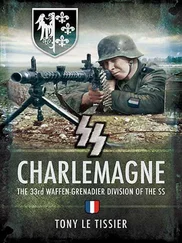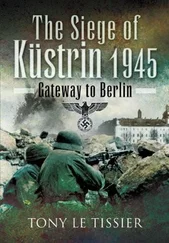An all-round defence was established and Babick set up his command post in a cellar behind the Reichstag, from where there were several underground tunnels leading to other buildings. The Reichstag itself had been walled up after the 1933 fire, presumably to prevent further arson attempts.
The Russian attack began with a massive artillery barrage. As the attacking infantry of the 150th Rifle Division wheeled left out of the Ministry of the Interior building, it came under strong flanking fire from the fortified Kroll Opera House, the ‘Nordland’ tanks in the Tiergarten and Zoo Flak-tower. The attack had been launched immediately after securing the Ministry of the Interior, by which time the division had been reduced to only two regiments, without time for either rest or reconnaissance, and it soon foundered. Meanwhile the 171st Rifle Division had launched an attack on the eastern half of the Diplomatic Quarter across Alsenstrasse with an equal lack of success and at a heavy cost.
The corps commander, realising he would have to clear the Kroll Opera House, called in his reserve 207th Rifle Division, which had first to clear the lightly defended Schlieffenufer block alongside the Spree in order to get at the Opera House. The Russians were under tremendous pressure as Stalin wanted the Red Flag hoisted on top of the Reichstag in time for the May Day celebrations. Additional artillery, tanks and rocket launchers were brought across to reinforce the Ministry of the Interior building in preparation for the next attack.
The second Soviet attack stalled on the line of a cutting for a U-Bahn tunnel that ran across Königsplatz to the Diplomatic Quarter and was not shown on the Russians’ maps. This abandoned worksite was flooded and its depth and steep sides made it an ideal anti-tank obstacle, which had naturally been incorporated into the defensive system.
Although the 171st Rifle Division managed to secure the eastern half of the Diplomatic Quarter as far as the Kronprinzen Bridge, the 150th Rifle Division stuck fast on the line of the ditch under heavy fire from the Reichstag, so it was decided to await the cover of darkness for the final assault.
With nightfall at about 1800 hours, the Russian tanks became invisible to the Zoo Flak-tower and were able to get round the flooded ditch to give support to the infantry storming the building. The infantry used mortars firing horizontally to blast a small hole in the bricked-up doorway and, supported by the fire from the supporting tanks and self-propelled guns, were able to enter the building itself, where merciless close-quarter fighting broke out, gradually spreading over the various stories of this vast building. But it was very dark inside, which placed the newcomers at a serious disadvantage to the defenders who knew their way around.
The military council of the 3rd Shock Army had issued a special Flag No. 5 for this historical occasion and sent it forward under an escort of Communist Party members. Two sergeants were able to slip through and find a way up to the roof and hoist the flag. The official account and the photographs and filming taken next day to commemorate the event for posterity, showed them holding the flag against one of the pepperpot-like ornaments on the rear parapet of the building overlooking the Brandenburg Gate, with the claim that this had occurred seventy minutes before May Day. The two sergeants were awarded the golden stars of ‘Hero of the Soviet Union’ for their deed. However, it later transpired that the first Red Flag to be hoisted over the Reichstag was in fact raised by an artillery captain on a statue above the front entrance well before midnight, whereas the sergeants had been two hours into May Day and had used an equestrian statue over the rear entrance as their prop. The photographer then made them change location because of the lack of background establishing the site, resulting in the famous picture that was published round the world. The captain received only the ‘Order of the Red Banner’ for his pains.
Fighting continued inside the building all day on 1 May and until 1300 hours on 2 May, when General Weidling’s order to surrender reached the survivors, who had by then been cut off from us for over thirty-six hours. Meanwhile, Soviet flamethrowers had started a fire within the building whose choking smoke made conditions even worse.
The attacking 79th Rifle Corps later claimed to have taken 2,000 prisoners and counted 2,500 German dead in these assaults on the Reichstag, Diplomatic Quarter, Schlieffenufer, Moltke Bridge and Kroll Opera House, but these figures are wildly exaggerated, as I have shown. Their own war memorial built close to the site significantly contains the bodies of 2,200 soldiers presumably killed in this same action.
THE BREAK-OUT FROM FRIEDRICHSTRASSE
The one-armed lieutenant, followed by Kurt Abicht and his men, came down to see me. He said that both his guns were now useless scrap and he thought that we were finished. My mortars were also useless for lack of bombs, and our rockets had long since been used up. We were now just simple infantrymen. We still had our machine gun with six hundred rounds and plenty of ammunition for our sub-machine guns, but that was all.
Losses among my own men had been thankfully few. This may have been because I preferred to do things myself rather than endanger others, but I cannot be sure. One of the sergeants had been wounded when he was buried under debris, but he could move around easily enough and was back on light duties.
As usual I went up to our barricades on the upper level on the night of 1/2 May. We still had not organised a shock troop, as we had been ordered from above, but fortunately we were spared this, and now we had been reinforced in our positions by the one-armed lieutenant and his men. Though they were not armed for close combat like ourselves, we now numbered about sixty in all. Claiming that he was no infantryman, the lieutenant handed over command to me.
I converted a former ticket office cabin into a quiet corner for myself and settled down there to doze. Suddenly a runner appeared with orders for the lieutenant and myself to report to the battalion commander. The lieutenant took along his battery sergeant major Kurt Abicht, and I took two of my Hitler Youths as runners. As usual they were as keen as mustard.
When we got to the command post on the lower level we found the battalion commander and his staff sitting there in the former platform guard’s office with faces that looked pale and distraught in the candlelight. Schäfer said to his adjutant: ‘Right, SS-Lieutenant Krönke, we are all here, you can begin.’
When I asked about the missing company commanders, Schäfer said; ‘We don’t need them at the moment. SS-Lieutenant Krönke has just returned from an order group with SS-Brigadier Mohnke at the Reichs Chancellery.’
Krönke read out what he said were the Führer’s last orders. We were thanked for our loyalty to the Führer and released from our oath to him. We were then informed about the new government that was to be formed, of which still in Berlin were Dr Josef Goebbels, the new Reichs Chancellor, and Martin Bormann, the Party Minister. Anyone could now go if they so wished.
However, SS-Brigadier Mohnke had cancelled the latter statement with written orders for a break-out of all Waffen-SS troops under his command to go north from Friedrichstrasse. General Weidling’s Army troops would break out to the west to join up with General Wenck’s forces. SS-General Steiner would thrust toward us with his divisions and take us on to join our friends the Americans.
(This sounded odd to me, for I had never heard of such ‘friends’ before. Only six months before these ‘friends’ had killed my parents with a direct hit by a bomb on their country home.) Mohnke would lead the break-out from Friedrichstrasse himself, according to these orders.
Читать дальше












